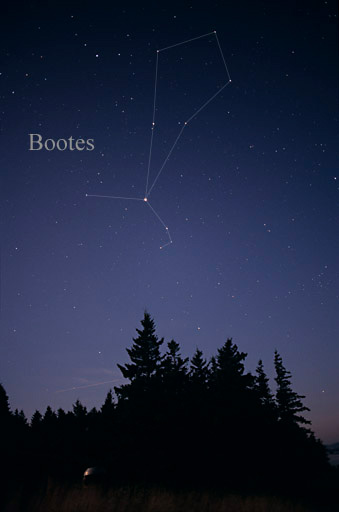
Izar shines as the second brightest star in the Boötes constellation, which is best viewed in late spring. It also so happens to be a binary star.
This distinguished binary takes some work to split with a telescope. But the labor is worth it! Upon separating the two stars, the backyard astronomer is rewarded with an alluring view: one large, orange star with a tiny, greenish-looking star nestled beside it.
Granted, observers may see a different set of colors, but most will agree with the German astronomer F.G.W. Struve.
Upon splitting the stars, Struve used the Latin word Pulcherrima, meaning “loveliest.” To enjoy this view, a scope with a 3-inch diameter or larger is recommended; however, a smaller scope can split the pair under excellent sky conditions. 1
Both of Izar’s primary and secondary components are many times more luminous than our own sun. It’s no wonder we can see the two from their place in the galaxy, some 200-300 light-years away from Earth. And on the subject of distances, Jim Kaler estimates that both are separated by approximately 185 Astronomical Units (1 AU is the distance between the Earth and the Sun). 1
So, you may be wondering: What role does science fiction play in Izar’s history? The science fiction writer and astronomer Duncan Lunan claimed to have interpreted a message sent from the inhabitants of a planet orbiting Epsilon Boötis. The original story about the alien message was reported in Time magazine in the 1920s, before Lunan was born.
What’s interesting is that the Scottish writer revoked the account of his interpretation, but then later reinstated his original claim. Nothing more came of this piece of science fiction, but the original mention of Izar in Time magazine managed to shed celebrity light on this dim, yet most lovely, binary star. 2
My Observations
| Date | May 21, 2022 |
| Time | 10:52 p.m. |
| Location | Seattle, WA |
| Magnification | 339x |
| Scope | Meade 8″ SCT |
| Eyepiece | 12mm w/2x Barlow |
| Seeing | Above Average |
| Transparency | Above Average |

As other observers have noted, this is a tough pair to split at first. Good sky conditions are needed. Tonight, I’ve been lucky to have favorable skies—a blessed break from the endless march of clouds in the Pacific Northwest over the last few months.
With the 12mm eyepiece, I see it’s a binary star due to the abnormal shape of the lighted pinpoint. Throwing in the 8mm helps considerably to split the pair. Regarding color, I’m in agreement with Jim Nanson’s recollection about the stars being orange and pale green—an observation close to that of British Admiral and astronomer William Henry Smyth, who said the stars were “pale orange” and “sea green.” For me, that “sea green” secondary star plays games with my eyes as it seems to switch between green and blue. 3
I believe Izar is remarkable for its contrast in color and size. Seeing the tiny pale green dot living right up close to its larger orange brother makes for a great sight every backyard astronomer should see.
Key Stats
| Constellation | Boötes |
| Best Viewing | Spring |
| Visual Magnitude | +3.3 | +4.8 |
| Absolute Magnitude | +1.47 |
| Separation | 2.9″ | 272 AU |
| Position Angle | 347° |
| Distance from Earth | 306 ly |
| Orbital Period | Unknown |
| Milky Way Location | Orion Spur |
| My Viewing Grade | B+ |
| Designations | SAO 83500, ε Boötis, ε Boo, 36 Boo, SAO 83500, Struve / STF 1877, HIP 72105 |
Sources and Notes
The double star banner on this page is an artist’s impression showing the double star AR Scorpii and not Izar. However, I liked the image in relation to what Izar looks like as a double. The source is found online here at eso.org. The author is M Garlick / University of Warwick / ESO. This file is licensed under the Creative Commons Attribution 4.0 International license.
Sketch by Wayne McGraw
1 Izar. (n.d.). Retrieved June 2, 2022, from http://stars.astro.illinois.edu/sow/izar.html
2 Duncan Lunan. Academic Dictionaries and Encyclopedias. (n.d.). Retrieved June 2, 2022, from https://en-academic.com/dic.nsf/enwiki/5549635
3 Izar (Epsilon [ε] boötis). Star-Splitters. (2013, February 5). Retrieved June 2, 2022, from https://bestdoubles.wordpress.com/2010/05/31/izar/
4 Photo by Till Credner. This file is licensed under the Creative Commons Attribution-Share Alike 3.0 Unported license.

One thought on “Izar (Epsilon Boötis): A Bit of Science Fiction and Loveliness”